- Category
- Anti-Fake
How Russia Fabricates Reality to Feign Innocence While Bombing Civilians
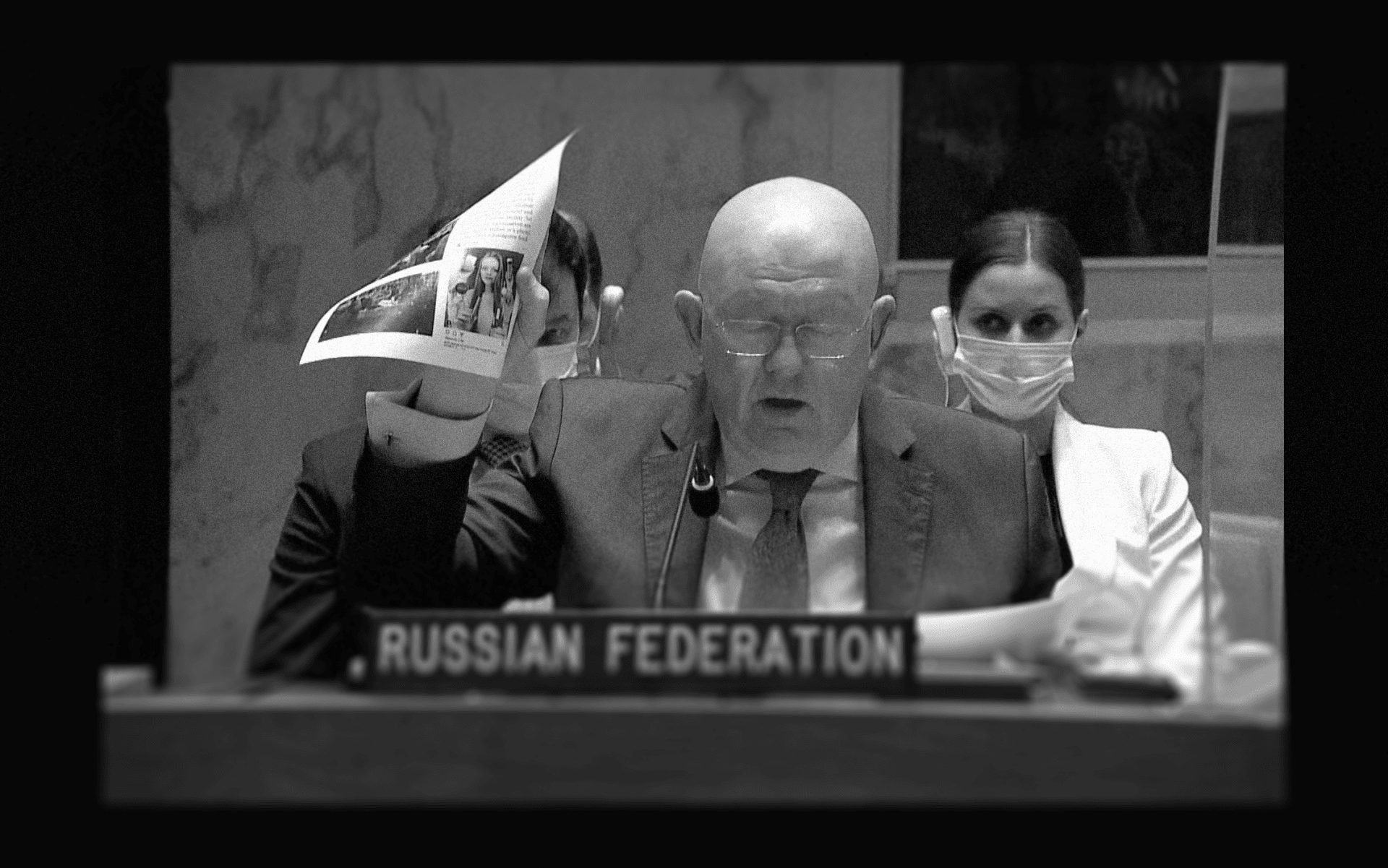
Before Russian missiles strike Ukraine’s hospitals or train stations, the lie is already in place. Researchers have uncovered a coordinated disinformation tactic known as an “information alibi,” used to deflect blame and obscure responsibility for war crimes. Now, efforts to hold the propagandists behind these deceptions criminally accountable are underway.
Can propagandists be held accountable for war crimes? People sometimes point to cases like Nuremberg or Rwanda, where media figures were prosecuted for inciting atrocities. But those are the outliers. Legal accountability for propagandists remains incredibly rare, and proving they intended their words to lead to war crimes is a steep legal climb.
But the authors of a new in-depth report, Manufacturing Impunity: Russian Information Operations in Ukraine, argue that the digital age is changing that. The report tracks a tactic called an “information alibi” that may help prosecute those behind the lies.
Almost every Russian war crime in Ukraine that has captured international attention comes with a preplanned, carefully planted excuse. A lie, seeded days in advance through a wide network of actors, is designed to shift blame onto Ukraine and mislead journalists, politicians, and the general public by sowing doubt.
As soon as an attack happens, they point back to the story they planted, using it as evidence of Ukraine’s involvement. Its purpose? To obstruct accountability. Those doing it? They know an attack is imminent because they’re preparing the justification in advance.
And it’s precisely this foreknowledge and orchestration that could help build a legal case.
Thanks to their digital footprint and predictability, these lies are traceable, allowing researchers to map propaganda campaigns directly to the crimes they precede. There’s a real chance to draw a Kremlin-shaped line—from rhetoric to atrocity.
Can propagandists like Zakharova and Solovyov be held accountable for war crimes?
— UNITED24 Media (@United24media) May 8, 2025
A new report revelead evidence of a tactic, called an "information alibi," that could make it possible.
Courtesy of @GRC_HumanRights @WayneJordash. pic.twitter.com/YcilfLrx1g
What are information alibis and how do they work?
In the weeks and days leading to Russia launching deadly attacks on civilian infrastructure, a distorted narrative and a series of falsehoods are spread across the information space through pro-Russian media, official government statements, telegram channels, and more.
(An example of information alibis is) When Russians want to bomb a place, for example, Kremenchuk Railway Station, . . . they (will say in advance that) Ukraine was going to do it, and then they do it.
The Ukraine Center for Countering Disinformation (CCD)
This marks the beginning of Russia’s information alibi, justifying its attacks even before they occur.
The report found that a vast network of key actors, including Russia's leader, Vladimir Putin, and his close advisors, perpetuates these false narratives, providing Moscow with plausible deniability for a crime they would later commit.
During and after the attack, Russia refers back to the planted information alibi, which provides a different version of events in an attempt to evade accountability for the attack.
(Information alibi is a strategy that) consists of proactively accusing the other party of actions that will actually be committed by the accusers themselves.
Detector Media
Ukrainian NGO
This forces journalists to report Russian lies alongside reality, confusing, deceiving, and seeding doubt within the information space, while disrupting and delaying thorough investigations into the attack.
“This tactic..represents a cynical weaponization of rhetoric as part of Russia's broader military strategy,” the report states.
Russia’s information alibis have involved claiming Ukraine is planning on launching an attack, which Russia then proceeds to conduct, claiming civilian infrastructure is used as military strongholds, then accusing injured civilians photographed in the attack of being “staged actors.”
When has Russia used its information alibis?
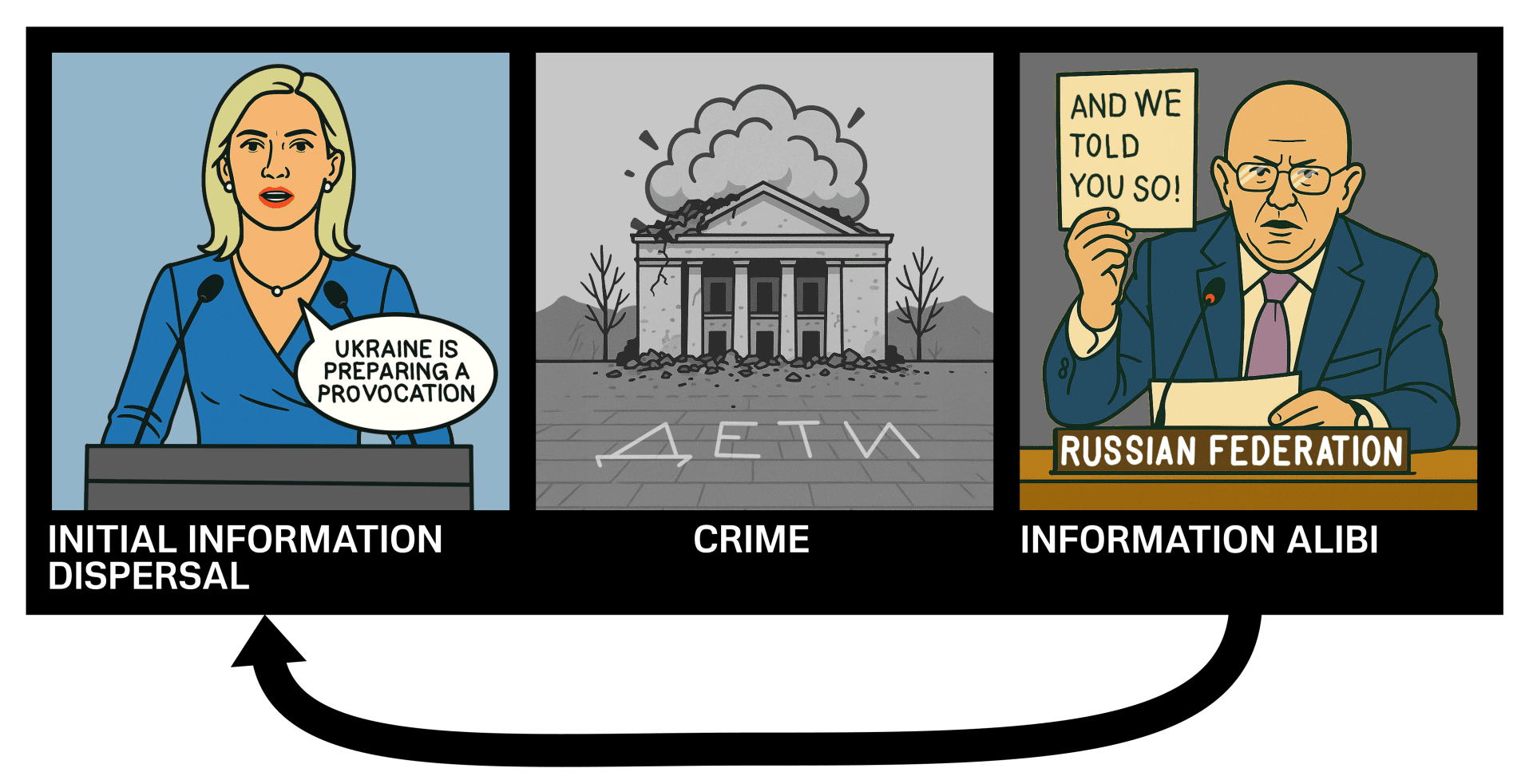
Russia’s attack on Mariupol Maternity Hospital No.3
A Russian March 22 airstrike devastated Ukraine’s Mariupol’s Maternity Hospital No. 3, killing at least three individuals and injuring at least 17 more. Before the attack, Russia’s information alibi had already flooded the information space.
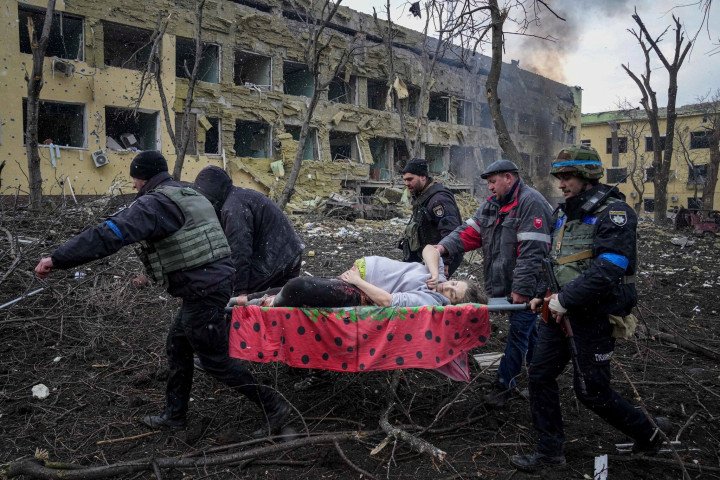
Kremlin officials and pro-Russian media were falsely accusing Ukrainian forces of using their civilians as human shields in Mariupol and of interrupting civilians' evacuation efforts starting the first days of Russia’s full-scale invasion.Leading up to the hospital attack, Igor Konashenkov, spokesperson for the Russian MOD enforced these claims.
Konashenkov and Russian media accused Azov of establishing military positions in several hospitals in Mariupol, including No. 3.Vassily Nebenzia, representative of the Russian Federation to the UN reiterated these claims just two days before the attack, during a meeting of the UN Security Council.
On the day of the attack, Russian foreign ministry spokeswoman Maria Zakharova also falsely claimed that Ukraine’s military was positioned inside the Maternity Hospital No. 3.
Four hours later, eyewitnesses reported a plane overhead—then a blast. Hospital No. 3 was hit.
Associated Press reporters photographed Marianna Vyshemirskaya (Podgurskaya), a pregnant woman injured in the attack, with blood on her face. Her photo provoked international condemnation.
I received threats that they would come and find me, that I would be killed, that my child would be cut into pieces.
The Russian Embassy in the UK and pro-Kremlin media smeared her as an actress staging the scene.
The day after the attack, the Russian MoD referred to its information alibi and released a statement indicating that numerous hospitals, including No. 3, ceased regular operations, that all patients had been previously evacuated, and again claimed that it was being used as a military position for Ukraine’s Azov Battalion.
This is how the Russian Embassy in London has responded to the bombing of the maternity hospital in Mariupol. Utterly obscene. pic.twitter.com/l4Udc1SmM0
— Carole Cadwalladr (@carolecadwalla) March 10, 2022
Disproving Russia’s information alibi
UN missions confirmed the hospital was active and identifiable at the time Russia hit it. The OSCE found no evidence of military use and classified the strike as a war crime and a clear violation of international humanitarian law (IHL), concluding that the hospital was destroyed by a deliberate Russian attack.
No evidence of the maternity ward being used as a military position was found.
Russia's attack on the Mariupol Drama Theatre
In March 2025, Russian fighter aircraft deployed two 500-kilogram bombs against the Mariupol Drama Theatre, which was providing shelter for reportedly up to 600 civilians, including children.
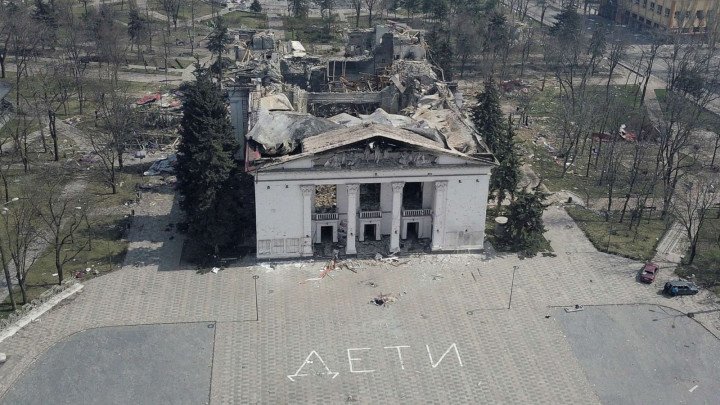
The word “ДЕТИ’ (lit. “CHILDREN”), which could be seen from aerial attack aircraft, had been inscribed in large letters on the ground outside the theater building in a bid to keep the children taking shelter there safe.
From the beginning of Russia’s full-scale invasion until its targeting, the facility had housed between 1,000 and 2,000 civilians. It functioned as a hub for food distribution, water, and critical information regarding evacuation corridors.
Before the attack, Russian military bloggers began circulating the narrative that Ukraine was planning a new “provocation” in the aftermath of the maternity ward disaster.Three days before the attack, a now-suspended account, Elena Evdokimova, posted on X that Ukraine was planning to stage shelling of the Drama Theatre, adding that the civilians were being held as hostages by the Ukrainian Army.
On the day of the attack, Daniil Bezsonov, the former so-called Deputy Minister of Information of the DPR (self-proclaimed “Donetsk People’s Republic”), again claimed that the Azov battalion was inside the drama theatre, using civilians as human shields and preventing them from escaping.Russian media and pro-war military bloggers continued with the narrative, even labeling the theater as an “Azov base.” Russian Telegram channels claimed that ‘CHILDREN’ written outside the theater was meant to safeguard the Azov Battalion.
The Russian Foreign Ministry asserts that Russia bears no responsibility for the bombing of the theater.
Disproving Russia’s information alibi
In its information alibi, Russia had admitted that it was aware that civilians were inside the building, as they falsely claimed to be used as human shields. Therefore, they knowingly targeted civilians. However, some changed their alibi, claiming that Azov had previously evacuated the civilians, likely in a bid to evade prosecution for a war crime. Russia had confused its alibi.
Amnesty International and the UN High Commissioner on Human Rights confirmed that the incident constituted an air strike; investigations also found no evidence that the Ukrainian military utilized the theater as a base for operations. The OSCE mission characterized the attack as being most likely an “egregious violation of IHL” and a “war crime”.
Russia’s attack on Kramatorsk Train Station
In April 2022, Russia hit Kramatorsk train station with a ballistic missile with a cluster munition warhead, releasing 50 submunition bombs. In the attack, Russia killed 60 civilians, including seven children, and injured 111, including 17 children, according to the report.
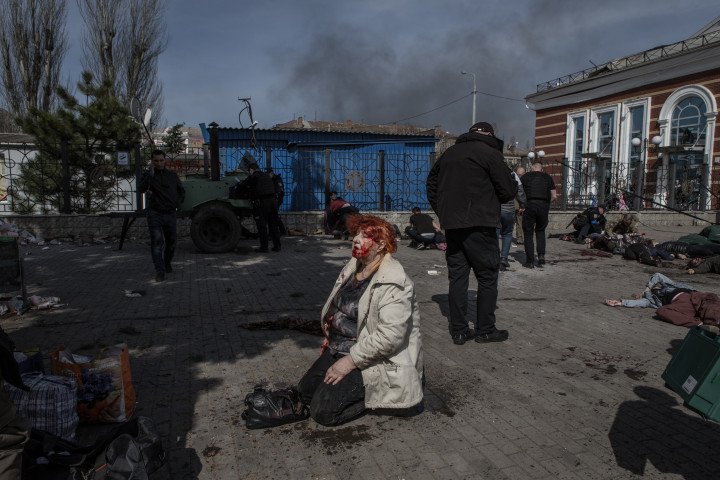
“I remember it very clearly,” Andrei Kovalov, a survivor of the attack, told the Guardian. “I thought I could hear a plane, and then I was thrown on the floor. People started shouting for everyone to get out of the station. Everyone was running. I tried to run, but I fell. I didn’t realize until then that I had blood all over me and holes in my body.”
Following the onset of Russia's full-scale invasion, the Kramatorsk train station became a significant transfer hub for evacuating thousands of civilians. In the days leading up to the attack, tens of thousands of civilians were successfully evacuated through it.
In the weeks leading up to the attack, Russian Telegram channels reported that a Ukrainian-launched Tochka-U missile had fallen near Kramatorsk and that it hadn’t been used by the Russian army since 2019.
This became one of several information alibis that Russia would use to evade responsibility for its attack on the station. They also falsely claimed that Ukraine was using its civilians as human shields.Leading up to the attack, Russian media warned Ukrainian civilians not to use the train evacuation line—the safest and quickest route of escape—without providing any further clarification.
On the day of the attack, the Russian state-owned agency RIA Novosti published a post on X regarding an explosion of a Tochka-U missile in Kramatorsk at 10:25 am.
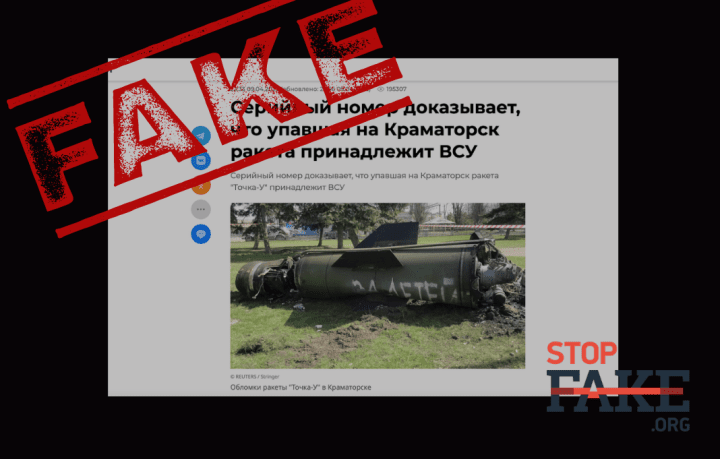
However, reports from eyewitnesses of the attack began at 10:30 am; RIA Novosti had published the story before the eyewitnesses to the crime.
RIA Novosti published the post via TweetDeck, an app that allows for the publication of pre-planned content. The post was deleted, but journalists had already captured screenshots.
Russian state entities, including the MOD, the MFA , and pro-Kremlin media, claimed that the strike did not occur and that Ukrainian forces launched the strike as a false flag operation. At the same time, continuing with their information alibi, they asserted that Russian forces don’t use the Tochka-U missile.
Disproving Russia’s information alibi
However, investigations conducted by the Institute for the Study of War (ISW) and Bellingcat confirmed that the Russian Army is equipped with the Tochka-U missile. Affirming their findings by evidence of the Tochka-U missiles transported from Belarus to Belgorod, with the vehicles displaying the Russian pro-war ‘V’ sign.
Human Rights Watch stated that the station’s use for civilian evacuations had been publicly announced and that the crowds of civilians at the station would be visible to Russia’s aerial surveillance.
The network behind Russia’s information alibi operation
Russia treats information warfare as a central tool of state power, mobilizing a complex network of Kremlin officials, members of the state security services, private entities, and individuals unaffiliated with but tangentially connected to the Russian state, among others, to spread disinformation. Understanding the structure and hierarchy of Russian information operations is key to identifying those responsible for disseminating harmful narratives.

Russia’s political leadership
At the top are Vladimir Putin and key advisors like Sergey Kiriyenko, Alexey Gromov and Sofia Zakharova—so-called “curators” of the Kremlin’s propaganda machine. Gromov oversees traditional media; Kiriyenko manages digital operations, with his son Vladimir heading VK, Russia’s largest social platform. Zakharova was sanctioned by the US for her role in the Doppelganger disinfo campaign
Russian-installed officials in occupied Ukrainian territories, such as Vladimir Leontyev in Nova Kakhovka, also spread false claims—for example, blaming Ukraine for the Kakhovka dam’s destruction.
Russia’s executive bodies
The Ministry of Defence (MoD) and its spokesperson, Igor Konashenkov are central to disinformation efforts, pushing false claims amplified by state media. Foreign Minister Sergey Lavrov, MFA spokeswoman Maria Zakharova, and UN representatives like Vassily Nebenzia and Dmitry Polyanskiy also disseminate fabricated narratives.
Maria Zakharova was among the first to circulate a fake video with the BBC’s logo—originally from a troll account—falsely claiming 1,000 Ukrainian soldiers supported Nazism. The story was echoed by embassies, TV presenters, and pro-war bloggers like Sergei Kolyasnikov.
Pseudo-NGOs
Groups like ANO Dialog and Social Design Agency (SDA) act as disinformation hubs while posing as independent NGOs. ANO Dialog, linked to Kiriyenko and the MoD, runs the “War on Fakes” project. Russian news outlet Meduza reported it controls a vast Telegram and social media network and used more than 100,000 social media pages to spread fake news designed to discredit and undermine the government of Ukraine, amounting to a “wartime disinformation” machine.
Leaked documents show SDA functions as a bot farm and psychological warfare center. In early 2024 alone, its “Russian Digital Army” generated nearly 34 million comments and over 39,000 posts—including thousands of memes and videos. Its fakes include a fabricated child abduction story that fooled Western media. “That’s a success,” boasted Sofia Zakharova.
Pro-Russian telegram channels and media outlets
Russia’s information ecosystem includes TV propagandists, media outlets, and administrators of pro-war Telegram channels—some state-linked, others semi-independent. Various Russian Telegram channels like WarGonzo, Operation Z, Smotri, Khersonskiy Vestnik, and Kremlevskaya prachka played key roles in disseminating false information about Ukraine. Outlets like Readovka, Pul №3, ANNA-NEWS, and War on Fakes consistently echoed Kremlin messaging with lies and conspiracy theories.
Putin and MoD officials (Defence Minister Sergei Shoigu, Defence Ministry’s PR lead, Igor Konashenkov, and others) have hosted meetings with war correspondents and pro-Kremlin Telegram admins to coordinate messaging. ANO Dialog has also convened such coordination sessions, involving representatives of the pro-Kremlin Telegram channels like Readovka and Mash, one of the largest “tabloid” channels.
Can those who deploy information alibis be criminally prosecuted?
The new report outlines how these “information alibis” function and who deploys them. It also serves as a blueprint for investigators, prosecutors, and journalists in their efforts to counter disinformation and promote accountability for Russia’s crimes.
Investigators, journalists, and researchers are now working to expose every fake alibi and every war crime committed by Russia against Ukraine, Syria, and other nations globally.
The ICC, the UN, and civil society organizations all have a crucial role to play in countering information alibis and ensuring that those who manipulate the information landscape for criminal purposes are held responsible for their actions, the report said.
“Only through such collective action can we hope to safeguard international peace and security,” the report concluded.
-46f6afa2f66d31ff3df8ea1a8f5524ec.jpg)
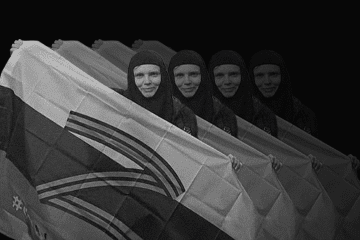
-8ddd9e24f95bb9d73d6d11d75f774999.png)
-29a1a43aba23f9bb779a1ac8b98d2121.jpeg)
-283d77c1379d612e6f72cf1b6de7dacb.png)
